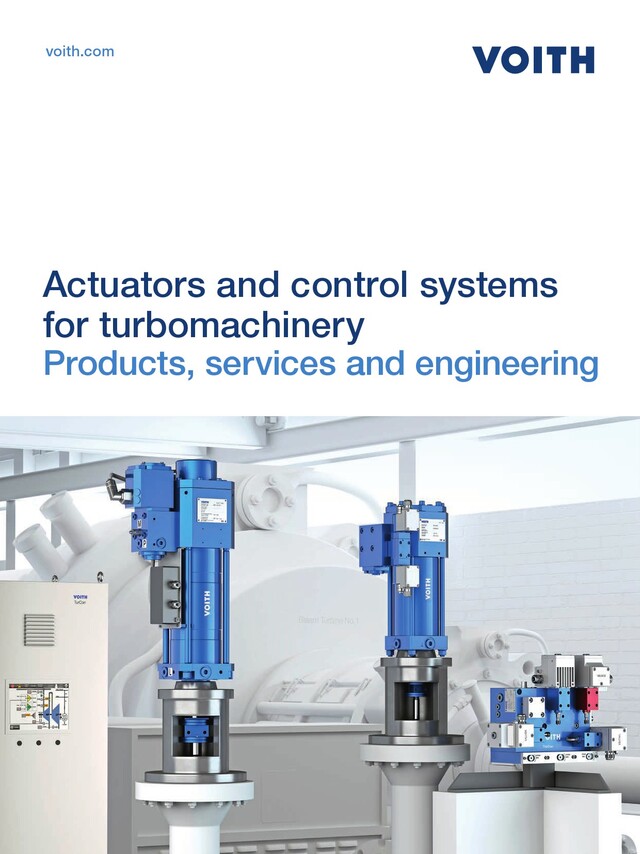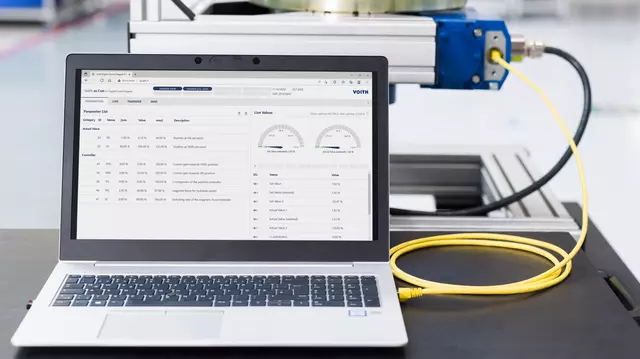| Features |
Advantages |
Benefits |
| Process and system expertise |
- Integrated approach to the entire turbomachinery control system (actuators and controls).
- Expert advice on the design, use and cost-optimized operation of the entire control system.
|
- Access to more than 30 years of experience in the interaction of distributed control system (DCS), controller, actuators and steam turbine/compressor.
|
- You will receive a technically sophisticated and highly cost-effective actuator and control solution with optimum investment and operating costs (TCO).
|
- Interaction of controller and actuators taken into consideration.
- Availability of a wide range of redundant and non-redundant actuators.
|
- The controller software is tailored to actuator types; for example, special test routines are implemented for the various actuators and valves (partial stroke test, redundancy tests, motion tests etc.)
- The control algorithms leverage all actuator functions.
- If the control system is upgraded, suitable actuators will always be available.
|
- The high level of operational reliability of the entire control system makes an important contribution to the availability of your machinery.
- Test routines for the actuators and valves during operation increase the reliability of your steam turbine or compressor.
- Necessary maintenance tasks can be identified in good time and effectively planned.
|
- The control solution is designed for all makes of steam turbines and compressors and any power class.
|
- The same controller can be used for various turbines and compressors.
|
- You have the ideal prerequisites for spare parts management.
- Operating personnel only need to be familiar with one control system.
- You have a reliable partner for all your turbine drive systems.
|
| Fit for the future |
- Can be upgraded for future functions such as new control modes or additional limiter functions.
|
- Controller software or the number of inputs and outputs can be easily expanded.
|
- The control system can be adapted to altered requirements with little effort and at low cost. There is no need to immediately replace the entire control system.
|
- The controller is Industry 4.0 (IoT)-capable.
|
- All relevant data can be retrieved via a range of communication interfaces.
- A data recorder is optionally available.
|
- You get a controller that is future-proof for a very long time.
|
| Visualization, diagnosis and optimization |
- Meaningful visualization images with extensive diagnostic capabilities.
|
- All digital and analog input and output signals can be directly displayed.
- All output signals can be “forced”.
- All input signals can be “simulated”.
- The operating conditions of all controllers and limiters are visualized in detail.
- The fault monitoring system displays status, warning and alarm messages in a clear format with time stamp.
|
- Operating personnel can conduct extensive diagnoses quickly and without external support.
- Process sequences and process faults in your plant can be tracked in a very short time and in a targeted manner.
- All of this increases system availability, product quality, and last but not least, the productivity of the entire plant.
|
- Web visualization via Ethernet (LAN) and specified web browser.
|
- The complete visualization can be accessed with standard hardware and software.
- Several devices can access TurCon visualization simultaneously.
|
- There are no additional licensing costs to access TurCon visualization.
- You use the visualization without special client software and you do not need “admin rights” on your PC.
|
- 15 inch TFT-LCD control panel with intuitive touchscreen operator interface.
|
- The HMI interface is user friendly and modern.
- All parameters can be adjusted on site and relevant process values visualized.
|
- Operating personnel can be trained very quickly in the use of the system.
- You have quick and informative process visualization and monitoring on site.
|
- RemoteView & Control via LAN using a standard PC with specified browser or optional 15” touch panel.
|
- All operating, setting and monitoring functions can be executed in the same way as on the standard control panel.
|
- You have an additional, inexpensive HMI interface at another location.
- A large-scale visualization, e.g. during commissioning or for monitoring purposes, can be realized quickly and easily.
|
- Integrated tool for controller optimization during operation without significant disruption to the process.
|
- The control loops and their control accuracy can be quickly optimized.
|
- You save costs thanks to shorter commissioning time.
- You quickly reach high process quality.
|
- Simulation option available for all controller functions during the factory acceptance test (FAT) and before commissioning.
|
- The basic accuracy of the configuration and parameter-setting of the turbine controller can be effectively checked and optimized if necessary before the commissioning process as such.
|
- A preliminary simulation facilitates commissioning and cuts commissioning time.
- You therefore minimize the risk of damage due to incorrect parameters.
|
- RemoteAccess & Control via VPN tunnel (optional).
|
- Voith can provide simple and fast support.
|
- You get a fast and cost-effective analysis of the behavior of the system.
|
| Hardware, software and redundancy |
- Modular structure with proven standard hardware suitable for industrial use.
- Scalable hardware redundancy for fault-tolerant systems.
|
- The components of the control system are ideally matched to one another.
- The controller is extremely flexible and suitable for all steam turbine and compressor applications.
|
- Your control system offers a high level of operational reliability and is consistently easy to maintain.
- The controller is ideally suited for both new builds and upgrades to existing systems.
|
- Smart redundancy concept: 2-channel CPU with 2-channel input/output units.
- Continuous monitoring of both channels.
- Up to 3 inputs for each process value with 2oo3 (two out of three) logic.
- Redundant outputs with self-monitoring function, specifically for the actuators.
|
- The failure of one controller unit will not cause the turbine or compressor to shut down.
- Controller components can be replaced during operation.
|
- Your entire plant has a high level of productivity.
- The high reliability and availability of the controller ensures long operating intervals in accordance with predefined maintenance schedules.
|
|
|
- I/O malfunctions can be detected in real time.
|
- You avoid system failures and the consequences caused by incorrect input/output status.
|
- Scalable software functionality for all customer requirements.
- Proven and reliable software algorithms for the control and regulation of turbomachinery.
|
- Existing software routines can be easily adapted to customer requirements.
- High software quality forms the basis for reliability, efficiency, safety and ease of maintenance.
|
- Short development cycles and low development costs are easy on your budget.
- The commissioning of the control system takes little time and effort.
|
- Direct control of all HP, MP and LP valve actuators.
- Linearization of valve characteristics via individually configurable control variables.
|
- In the case of turbines with more than one HP, MP or LP control valve, there is no need to adjust the valves mechanically using a camshaft.
|
- Fewer mechanical parts means you have lower maintenance costs.
|
- In the case of turbines with more than one HP, MP or LP control valve, no separate electronic valve coordinator (split range) is necessary.
|
- Fewer electronic components reduce the complexity of the system and improve its reliability, while you gain higher system availability.
- The commissioning effort is reduced, which saves significant costs.
|
- The steam turbine control valves can be actuated flexibly.
|
- You are flexible in the design of the process.
|
- Multilevel password protection.
|
- The operation of the controller is well protected.
|
- Your turbine control system is secure and protected from unauthorized interventions.
|
































































